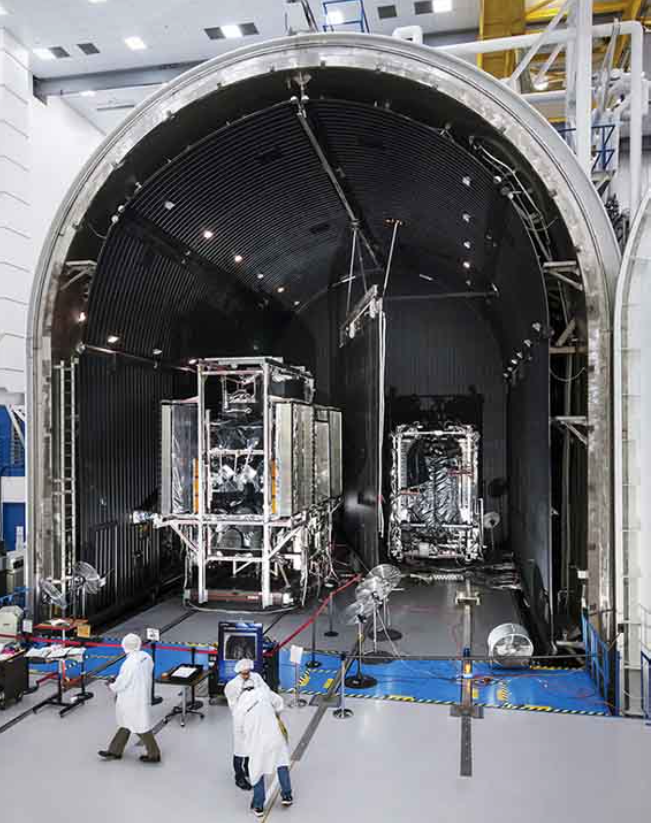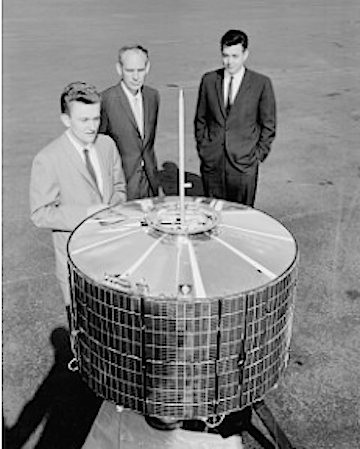
Stepping up to a belief the company has held for years, ViaSat's aim is to be the first global Internet service provider—a step that brings them ever closer when the company launches ViaSat-2.
At an informal press event, ViaSat revealed its latest and most advanced satellite, which will put the company on a path to be more competitive in the Internet market.

Carlsbad-based ViaSat is scheduled to launch its ViaSat-2 satellite in late March or early April. They partnered with Boeing to construct and test the satellite, which will increase ViaSat’s broadband Internet performance. The photo is of two Boeing 702 satellites in its thermal vacuum. Courtesy photo
At Boeing’s satellite facility on Tuesday, ViaSat and Boeing executives engaged in an hour-long presentation about ViaSat-2’s capabilities, their business partnership, plus a tour of the facility highlighted by revealing its state-of-the-art satellite. The total project cost, meanwhile, is about $600 million, which include the launch, satellite, insurance and ground equipment, and took three years to construct.
However, no photos were allowed to preserve company and technological strategies.
Nevertheless, ViaSat’s crown jewel stands 25-feet high, about 10 feet wide and, once its solar panels deploy in space, it will have a wingspan of 150 feet. Arianespace, a French company, will deliver the satellite on its Ariane 5 rocket.
“We’re really evolving toward, what we believe, is the first global Internet service provider,” said Dave Abrahamian, ViaSat’s director of space systems. “Our whole mantra for the past 10 years … is to reduce the cost per bit, increase capacity substantially so that satellite-based broadband is no longer the choice of last resort. We’ll move that ball significantly forward when we launch ViaSat-2.”
ViaSat-2, meanwhile, will have roughly two times more the capacity than ViaSat-1, when it launched in 2011, for a total capacity of 300 gigabits per second (Gbps). With 300Gbps of capacity, it will give customers download speeds between 25 to 50Mbps. It will also providing seven times more coverage.
With a successful launch, which is scheduled for March or April in French Guiana in South America, ViaSat-2 will expand the Carlsbad-based company’s reach across the Atlantic Ocean to the Middle East and the northern tip of South America.
Alaska will be the only state not to receive coverage from ViaSat-2 due to the angle of Earth.
“We don’t have to sacrifice capacity for coverage area,” Abrahamian explained. “We can also move capacity around. ViaSat-2 solves that problem.”
In addition, the increase in ViaSat’s reach and capacity will allow its customer base to increase by an estimated two to three times, said Keven Lippert, executive vice president of Satellite Systems and Corporate Development at ViaSat. Currently, the company has about 700,000 residential and business users on its ViaSat-1 satellite plus more than 550 commercial aircraft along with maritime vessels and the U.S. government.
Its domestic airline portfolio includes United, JetBlue, Virgin America and most recently, American Airlines.

The Syncom II prototype with the inventors from left to right Donald Williams, Thomas Hudspeth and Harold Rosen in the 1960s. It was the first-ever communications satellite and broadcasted the 1964 Tokyo Olympics. Courtesy photo
“We won the American Airlines contract first for their 737… and (a sizable portion of their) North American fleet,” Abrahamian said of the Boeing partnership. “We think we can compete favorably with cable providers. The cost per user…, which is their metric, is greatly, greatly in our favor. There is no great efficient means of providing broadband in a large area than satellite.”
Abrahamian said another advantage for the company comes from aircraft service. With the launch, and ViaSat’s European partner Eutelsat, 85 to 90 percent of all flight routes will be covered.
Lippert, though, said the ultimate advantages of the new satellite will allow the company to become more competitive in the Internet market. Notably, ViaSat can challenge low- to mid-tier cable and DSL Internet service providers.
In addition, ViaSat-2 will begin to ease data caps currently in place.
Abrahamian, though, said ViaSat-2 will dovetail into ViaSat-3, the company’s most aggressive effort to date. The project will launch a trio of satellites for global coverage and could eliminate the data caps plaguing Internet satellite companies.
It will be the first satellite with one terabyte of capacity, which is larger than the more than 400 combined communication satellites currently in space.
“I think the other point is our competition is more and more not other satellite companies,” Lippert said. “It’s DSL, cable and traditional telecom companies. That’s really our goal … and where we’re headed.”
As for Boeing’s role, the two companies partnered to build the ViaSat-2 satellite. ViaSat constructed the systems and the design, while Boeing built the satellite (a 702 high-power series) and performed the mandatory testing requirements plus delivery to the launch site.
Mark Spiwak, president of Boeing Satellite Systems International, and Ron Dukat, Boeing-ViaSat program director, said the partnership has flourished.
“What we can offer customers like ViaSat is the best of the best,” Spiwak said. “Certain customers, like ViaSat, have certain proprietary information that they may not want to share that and we respect that.”
As for the launch schedule, Abrahamian said ViaSat-2 had undergone and passed all testing performed by Boeing and is now waiting to be shipped to South America. Testing included temperature performances, where in space there is a 600-degree difference between light (300 degrees Fahrenheit) and shade (-300), noise exams up to 10,000 hertz and simulated space tests in Boeing’s thermal vacuum.
“You get one shot at this,” Spiwak added. “These are 22,000 miles away so it’s a pretty rigorous test program so it makes sure it works for 15 years or whatever the design life is on orbit. You can’t go up there and fix it.”
Once there, it will be fueled and launched into its orbital slot.
However, ViaSat will conduct numerous systems tests once the satellite is in space and will be operational for consumer use by the fourth quarter 2017, Lippert added.

